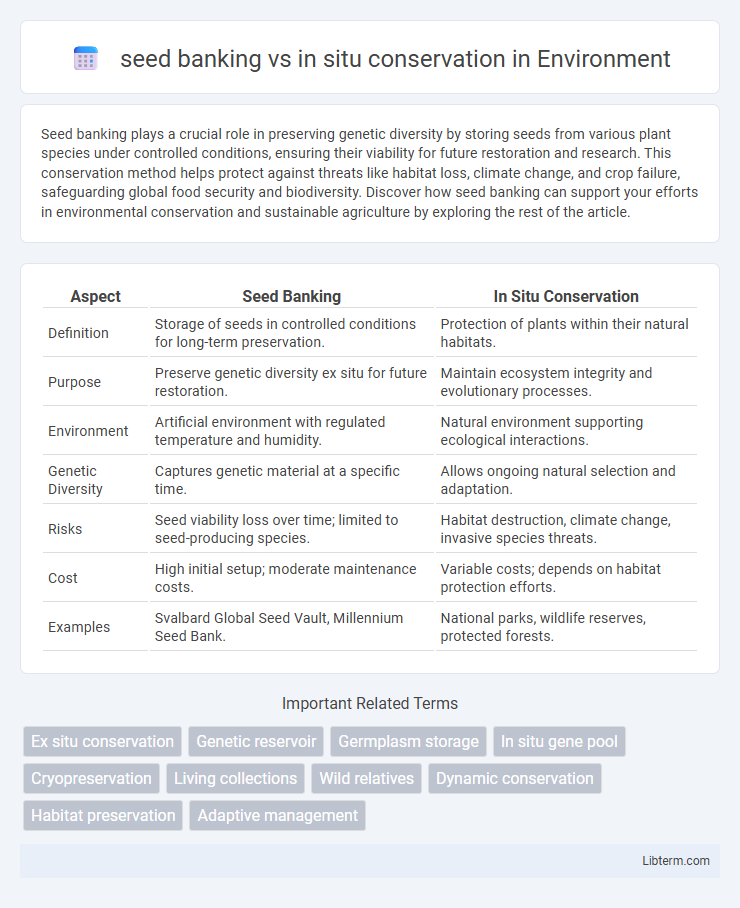Seed banking plays a crucial role in preserving genetic diversity by storing seeds from various plant species under controlled conditions, ensuring their viability for future restoration and research. This conservation method helps protect against threats like habitat loss, climate change, and crop failure, safeguarding global food security and biodiversity. Discover how seed banking can support your efforts in environmental conservation and sustainable agriculture by exploring the rest of the article.
Table of Comparison
| Aspect | Seed Banking | In Situ Conservation |
|---|---|---|
| Definition | Storage of seeds in controlled conditions for long-term preservation. | Protection of plants within their natural habitats. |
| Purpose | Preserve genetic diversity ex situ for future restoration. | Maintain ecosystem integrity and evolutionary processes. |
| Environment | Artificial environment with regulated temperature and humidity. | Natural environment supporting ecological interactions. |
| Genetic Diversity | Captures genetic material at a specific time. | Allows ongoing natural selection and adaptation. |
| Risks | Seed viability loss over time; limited to seed-producing species. | Habitat destruction, climate change, invasive species threats. |
| Cost | High initial setup; moderate maintenance costs. | Variable costs; depends on habitat protection efforts. |
| Examples | Svalbard Global Seed Vault, Millennium Seed Bank. | National parks, wildlife reserves, protected forests. |
Introduction to Seed Banking and In Situ Conservation
Seed banking preserves genetic diversity by storing seeds under controlled conditions to ensure long-term viability, supporting species conservation and restoration efforts. In situ conservation maintains plant populations within their natural habitats, allowing ongoing adaptation to environmental changes and preserving ecosystem dynamics. Both approaches are critical for comprehensive biodiversity preservation, complementing each other in safeguarding genetic resources.
Defining Seed Banking: Concept and Process
Seed banking involves the collection, drying, and storage of seeds in controlled environments to preserve genetic diversity and ensure long-term viability. This ex situ conservation method protects plant species by safeguarding seeds from environmental threats and habitat loss. The process includes cataloging seed species, monitoring seed health, and periodically regenerating stocks to maintain genetic fidelity.
Understanding In Situ Conservation: Principles and Practices
In situ conservation involves protecting plant species within their natural habitats, maintaining ecological processes and genetic diversity critical for long-term species survival. This approach supports the preservation of entire ecosystems, allowing plants to adapt to environmental changes and maintain evolutionary potential. Unlike seed banking, which stores genetic material ex situ, in situ conservation ensures ongoing natural regeneration and habitat-specific interactions essential for species resilience.
Key Differences Between Seed Banking and In Situ Conservation
Seed banking preserves plant genetic material ex situ by storing seeds under controlled conditions, ensuring long-term viability and protection from environmental threats. In situ conservation maintains plant populations within their natural habitats, allowing ongoing evolutionary processes and ecological interactions to occur. While seed banking offers security against habitat loss and climate change, in situ conservation supports genetic diversity through natural adaptation and ecosystem dynamics.
Advantages of Seed Banking for Plant Genetic Diversity
Seed banking offers a secure and cost-effective method for conserving plant genetic diversity by preserving a vast number of seeds under controlled conditions, ensuring long-term viability. It enables rapid restoration of plant populations after environmental disturbances, pests, or diseases, supporting agricultural resilience and biodiversity. Moreover, seed banks provide accessible genetic resources for research, breeding programs, and habitat restoration efforts, enhancing global food security and ecosystem stability.
Benefits of In Situ Conservation for Ecosystem Health
In situ conservation maintains biodiversity by preserving species within their natural habitats, promoting ecological processes and interactions critical for ecosystem resilience. This method supports dynamic adaptation to environmental changes and sustains ecosystem services such as soil fertility, pollination, and water regulation. Unlike seed banking, in situ conservation enables continuous evolution and habitat-specific gene flow, enhancing long-term ecosystem health and stability.
Limitations and Challenges of Seed Banking
Seed banking faces limitations such as the risk of seed viability loss over time and sensitivity to storage conditions requiring constant monitoring. Some plant species produce recalcitrant seeds that cannot tolerate drying or freezing, making long-term storage unfeasible. Furthermore, seed banks cannot preserve genetic diversity linked to ecological interactions and evolving environments that in situ conservation maintains.
Drawbacks and Challenges of In Situ Conservation
In situ conservation faces challenges such as habitat destruction, climate change, and limited space that threaten the long-term survival of species in their natural environments. It often requires continuous monitoring, complex management, and significant resources to maintain ecosystem balance and protect genetic diversity effectively. Unlike seed banking, which allows for secure storage of genetic material off-site, in situ methods depend heavily on the stability and protection of natural habitats, making them vulnerable to external environmental changes and human activities.
Complementarity and Integration of Both Approaches
Seed banking offers a controlled environment for long-term preservation of genetic material, ensuring species survival during adverse conditions, while in situ conservation maintains dynamic ecosystems, supporting natural evolutionary processes and ecological interactions. Integrating both approaches enhances biodiversity conservation by safeguarding genetic diversity ex situ and promoting resilience through habitat preservation in situ. Complementarity arises as seed banks provide a backup for species at risk in natural habitats, facilitating restoration efforts and adaptive management strategies.
Future Perspectives in Plant Conservation Strategies
Emerging plant conservation strategies increasingly integrate seed banking and in situ conservation to enhance genetic diversity preservation and ecosystem resilience. Advances in cryopreservation and genomic tools improve seed bank viability and enable targeted restoration efforts, while dynamic in situ approaches support adaptive management under climate change. Collaborative frameworks combining ex situ and in situ methods are pivotal for sustaining plant biodiversity and ensuring long-term conservation success.
seed banking Infographic

 libterm.com
libterm.com